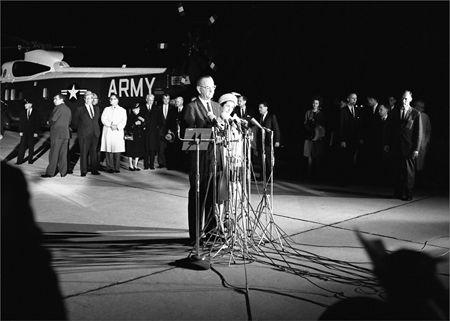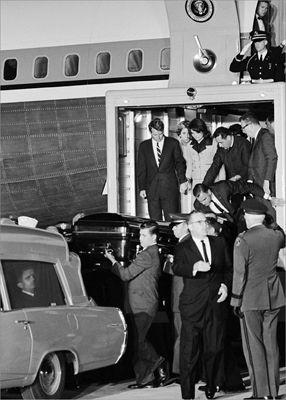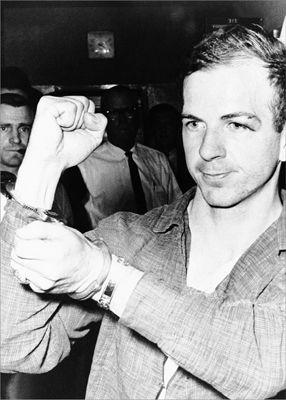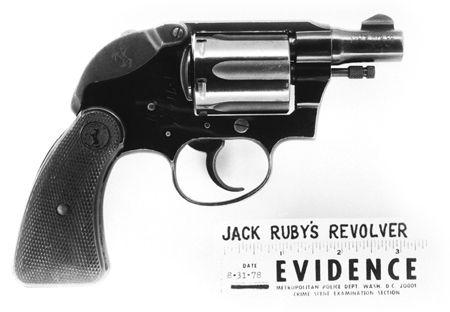Kennedy's Last Days: The Assassination That Defined a Generation (28 page)
Read Kennedy's Last Days: The Assassination That Defined a Generation Online
Authors: Bill O'Reilly

Lyndon Baines Johnson is sworn in as the 36th president of the United States, with his wife, Lady Bird, on one side of him and Jackie Kennedy on the other. He placed his hand on a missal found in Kennedy’s bedroom on the plane.
[JFK Presidential Library and Museum]
At 6:00
P.M.
people are glued to their televisions with depressed fascination. It seems as if everyone finds out what is happening at the same time. People watch news anchors answer phones and read notes handed to them as events unfold.

President Johnson addresses the nation live from Andrews Air Force Base in Maryland. “This is a sad time for all people. We have suffered a loss that cannot be weighed.”
[JFK Presidential Library and Museum]
The plane carrying John Kennedy’s body touches down at Andrews Air Force Base in Washington, D.C. Television cameras capture the transfer of the casket from the plane to an ambulance, and television announcers are silent as Jackie walks down the stairs.

Bobby Kennedy and Jackie Kennedy watch as the president’s coffin is moved from
Air Force One
to an ambulance at Andrews Air Force Base.
[Wally McNamee/Corbis]
Lyndon Johnson stands at news microphones to say his first public words as president: “This is a sad time for all people. We have suffered a loss that cannot be weighed. For me, it is a deep personal tragedy. I know that the world shares the sorrow that Mrs. Kennedy and her family bear. I will do my best. That is all I can do. I ask for your help—and God’s.”
The networks show the now heartbreaking footage of a smiling, vigorous Kennedy arriving at Love Field just that morning and plunging into the crowd to shake hands. Groups gather in front of U.S. embassies in foreign countries. Former U.S. presidents and leaders from around the world make statements.

Lee Harvey Oswald in police custody after his arrest. He was cut over his eye during the scuffle at the movie theater.
[© Bettmann/Corbis/AP]
And the world gets its first look at Lee Harvey Oswald as he is led to his cell.
CHAPTER FORTY
NOVEMBER 23, 1963
White House
I
N THE
E
AST
R
OOM OF THE
W
HITE
H
OUSE,
John Kennedy’s flag-draped casket lies on a curtained podium with honor guards always in attendance. Cameras capture members of the family as they walk into the building for a private mass. All day long, people pay their respects: former president Eisenhower, chief justice Earl Warren, the new president, family friends, senators, congressmen, and White House staff.
Robert Kennedy is assembling a list for the funeral on Monday. He sends a telegram to Martin Luther King Jr. inviting him to attend the funeral.

The Honor Guard places President Kennedy’s casket in the East Room of the White House. Mrs. Kennedy and Robert Kennedy are among the people near the door.
[JFK Presidential Library and Museum]
These two men cannot know that in five and a half years both will be dead at the hand of assassins.

Members of the Honor Guard remain with the casket at all times.
[JFK Presidential Library and Museum]

Robert Kennedy contacted leaders at home and heads of state from around the world with details of his brother’s funeral arrangements.
CHAPTER FORTY-ONE
SUNDAY, NOVEMBER 24, 1963
Dallas Police Department
L
EE
H
ARVEY
O
SWALD ARRIVES
at the Dallas Police Station at 2:00
P.M.
on Friday. In the next 45 hours he will be interrogated for 12 hours, be placed in four lineups, receive visits from his wife, mother, and brother Robert, and sleep in a maximum-security cell.
At a press conference just after midnight on Sunday, Lee Harvey Oswald tells reporters that the police are after him because he has lived in the Soviet Union. He denies shooting the president and denies that he is part of a larger conspiracy.
The Dallas police do little to shield Oswald at that press conference. Reporters are allowed to physically crowd the handcuffed suspect.
Later on Sunday, Oswald is to be transferred to the county jail. He is led through the basement of the Dallas Police Department, apparently to a waiting armored car. Actually, the armored car is a decoy—for security reasons, the plan is to take Oswald to a police car instead.

Oswald gestures to the crowd surrounding him.
[© Associated Press]
A crowd of journalists watch the smiling Oswald as he makes his way down the corridor, his right arm handcuffed to the left arm of Detective J. R. Leavelle. Three television cameras roll.
“Here he comes!” someone shouts as Oswald emerges from the jail office.
One of those crowding around is Jack Ruby. He made his way into the police station with a Colt Cobra .38 in his coat pocket.
Jack Ruby is five foot nine inches tall and 175 pounds, and is fond of carrying a big roll of cash. He’s a quick-tempered nightclub owner with friends in the Mafia and on the police force. Ruby considers himself a Democrat and a patriot. Like many Americans, he is infuriated by JFK’s death and he wants revenge. He can’t believe that Oswald is smiling. The crowd presses forward. Microphones are thrust at Oswald and questions shouted. Flashbulbs pop as photographers capture the moment for posterity. Oswald walks 10 feet outside the jail office, on his way to the ramp where the police car is waiting.

[© Corbis]
Suddenly, Jack Ruby emerges from the crowd. He moves fast, aiming his gun at Oswald’s stomach, and fires one shot. The time is 11:21
A.M.
